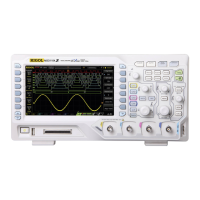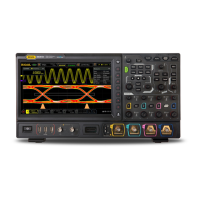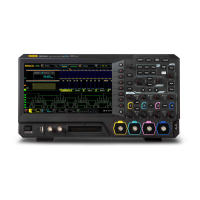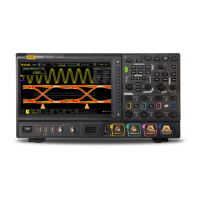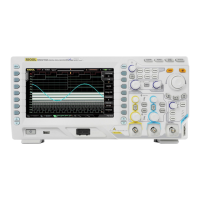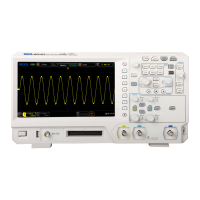Chapter 2 Command System RIGOL
MSO1000Z/DS1000Z Programming Guide 2-217
Command List:
:WAVeform:SOURce
:WAVeform:MODE
:WAVeform:FORMat
:WAVeform:DATA?
:WAVeform:XINCrement?
:WAVeform:XORigin?
:WAVeform:XREFerence?
:WAVeform:YINCrement?
:WAVeform:YORigin?
:WAVeform:YREFerence?
:WAVeform:STARt
:WAVeform:STOP
:WAVeform:PREamble?
:WAVeform:SOURce
:WAVeform:SOURce <source>
:WAVeform:SOURce?
Set or query the channel of which the waveform data will be read.
{D0|D1|D2|D3|D4|D5|D6|D7|D8|
D9|D10|D11|D12|D13|D14|D15|
CHANnel1|CHANnel2|CHANnel3|CHANnel4|MATH}
If the MATH channel is selected, only NORMal can be selected in :WAVeform:MODE.
If an digital channel (D0 to D15) is selected, the :WAVeform:DATA? command always
returns the waveform data in BYTE format. If the waveform data on the screen is
read, the signal status of the channel source currently selected is returned and a
waveform point occupies one byte (8 bits). If the waveform data in the internal
memory is read, the signal statuses of the channel group (D7 to D0 or D15 to D8; 8
digital channels) which includes the channel source currently selected are returned;
one byte represents the statuses of a group of digital signals and the data represents
the statuses of D7 to D0 (or D15 to D8) respectively from the highest bit to the
lowest bit.
The query returns D0, D1, D2, D3, D4, D5, D6, D7, D8, D9, D10, D11, D12, D13, D14,
D15, CHAN1, CHAN2, CHAN3, CHAN4, or MATH.
:WAVeform:SOURce CHANnel2 /*Set the channel to CH2*/
:WAVeform:SOURce? /*The query returns CHAN2*/

